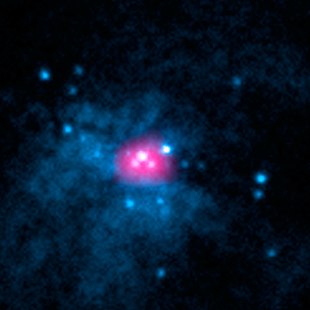M82 X-2
|
Pulsar M82 X-2 |
|||||
|---|---|---|---|---|---|

|
|||||
| M82 X-2 (red) and M82 X-1 (blue) taken with NuSTAR | |||||
|
Observation dates equinox : J2000.0 , epoch : J2000.0 |
|||||
| Constellation | Big Bear | ||||
| Right ascension | 09 h 55 m 51.04 s | ||||
| declination | + 69 ° 40 ′ 45.5 ″ | ||||
| Astrometry | |||||
| distance | 12 million ly 3.6 million pc |
||||
| Physical Properties | |||||
| Rotation period | 1.37 s | ||||
|
Other names and catalog entries |
|||||
|
|||||
| Aladin previewer | |||||
M82 X-2 is the second ultra-luminous X-ray source ( ULX ) in the Messier 82 galaxy alongside the M82 X-1 . The special thing about M82 X-2 is that the object is apparently an X-ray pulsar and not a black hole . The pulsed X-ray signal suggests nature as a pulsar.
Prior to the discovery of M82-X2, it was suspected that all ULXs were acceding black holes. As of 2014, the object is thus the brightest known accreting pulsar at all. The discovery has raised the question of whether neutron stars are possibly a common source of the ULX phenomenon.
observation
The object was examined with the NuSTAR telescope in 2014 as part of an observation of the supernova SN 2014J as well as with the Chandra satellite and Swift satellite .
properties
The pulsar has a mean period of 1.37 s and a second sinusoidal modulation over 2.5 days. It emits an energy of 4.9 × 10 39 ergs per second, the maximum being 1.8 × 10 40 ergs per second. This is about 10 million times the amount of energy radiated from the sun , although the pulsar probably has only a little more mass than the sun. The pulsar is thus also brighter than normally allowed over the Eddington limit . A possible explanation could be geometric effects. The subject of the investigation is currently the strength of the magnetic field . A study from 2017 comes to the conclusion that the magnetic field is less than 10 13 G (10 9 T ), which means that the object is probably not a magnetar .
companion
Little is known about the companion of the pulsar. However, it has to be quite massive to explain the brightness of the pulsar. Estimates assume at least 5 M ☉ assuming 1.4 M ☉ of the pulsar. So far, however, both masses could not be clearly determined.
Web links
Individual evidence
- ↑ M82 X-2. In: SIMBAD . Center de Données astronomiques de Strasbourg , accessed on July 13, 2018 .
- ↑ a b c d M. Bachetti, FA Harrison, DJ Walton, BW Grefenstette, D. Chakrabarty, F. Fürst, D. Barret, A. Beloborodov, SE Boggs, FE Christensen, WW Craig, AC Fabian, CJ Hailey, A Hornschemeier, V. Kaspi, SR Kulkarni, T. Maccarone, JM Miller, V. Rana, D. Stern, SP Tendulkar, J. Tomsick, NA Webb, WW Zhang: An ultraluminous X-ray source powered by an accreting neutron star . In: Nature . 514, October 9, 2014, pp. 202-204. arxiv : 1410.3590 . bibcode : 2014Nature.514..202B . doi : 10.1038 / nature13791 . PMID 25297433 .
- ↑ Suspected Black Hole Unmasked as Ultraluminous Pulsar. NASA , accessed July 13, 2018 .
- ^ Kun Xu, Xiang-Dong Li: On the Magnetic Field of the Ultraluminous X-Ray Pulsar M82 X-2 . In: The Astrophysical Journal . 838, No. 2, April 1, 2017, p. 98 (6pp). arxiv : 1704.00171 . bibcode : 2017ApJ ... 838 ... 98X . doi : 10.3847 / 1538-4357 / aa65d5 .